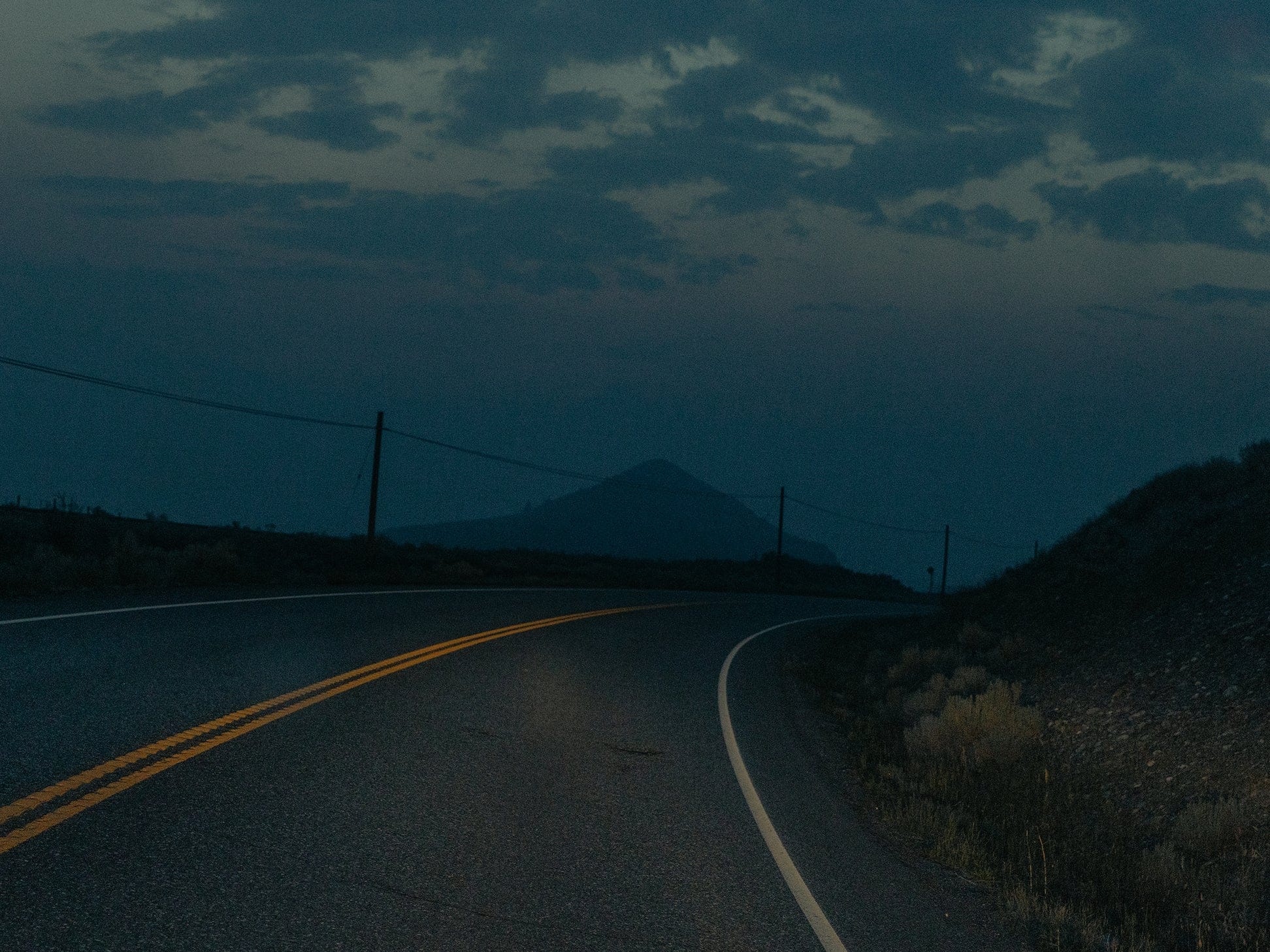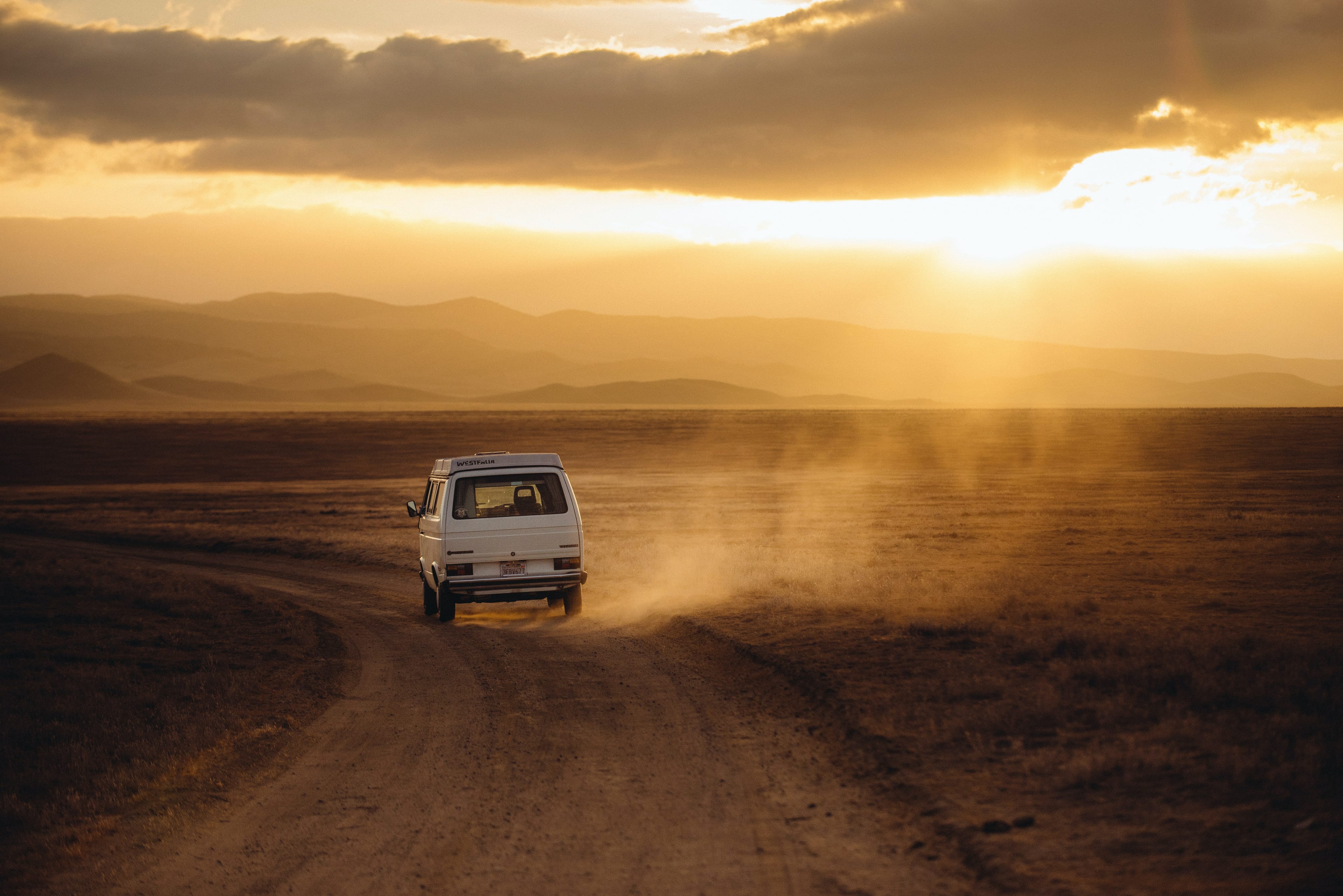The Vibrant, Wild World of California Redwood Trees
Rays of sunlight dance between trees in Del Norte Coast Redwoods State Park. | Ian Bates
Midway down the lush trail to the Grove of Titans in Jedediah Smith Redwoods State Park, I reach a ceremonial gate: two posts of elegant metal. It feels like a portal. “K’vsh-chu,” reads the left side: “redwood” in the Tolowa language. “Welcome to the deep forest,” says the right side. “Redwood forests help sustain life on earth. Please stay on the raised walkway.” I step up.
This boardwalk is a park engineering masterpiece. Made of wrought-iron grate, it protects the roots of the giant trees from trampling. Its path curves through fern and vine maple, past enormous trunks, reminding me of the Highline, New York City’s lofted subway track transformed into a promenade of grass and treelets above the streets. You could call this the Low Line, the understory line, a heart-of-the-rainforest rail. The metal dampens footsteps; the grate lets needles sift through. A slender banana slug extends its gummy antennae tentatively across one small, square abyss in the grid.
Meandering—this is how redwoods are meant to be explored. It’s as if here, the big trees have exclusive rights to moving in a straight line (albeit it skyward). It’s best if we humans wander and amble among them. The walkway encourages this. The grove’s core lies beyond an overlook, above clear-running Mill Creek, where coho salmon spawn in logjam pools. Here, the boardwalk turns a circle between a half dozen titans. An interpretive sign asks as you arrive: “What do you hear? ... What do you smell? ... What do you see?”
It’s Labor Day Weekend, yet I have these trees to myself—a rarity. The Grove of Titans was unknown—or lost, or kept hidden—until 1998, when two men stumbled upon it after a full-day of bushwhacking and named it and its trees. Now, during peak hours, two to four parties typically visit each minute. I took a ranger’s advice and waited until late evening. This is my first night of a four-day quest for the most magnificent, the most emblematic redwood grove I can find. Maybe I’ll even arrive at one remarkable tree—a titan among titans. But more than that, I want to absorb these trees’ importance, bask in their glory and gloom.
Even among the West Coast’s wonders, California’s big trees have a special significance as symbols of vibrant wildness—long the center of conservationist efforts, artists’ reveries and political battles. I’m out on the road to see what these icons have to say (in their own quiet way) in a time when news from the woods often revolves around forest fires and development threats. The area around Redwood National and State Parks seemed the right corner to commune with them. Only 5 percent of old-growth coast redwood, Sequoia sempervirens, still remains, and almost half of that remnant can be found in this cluster of parks, all within an hour’s drive on Highway 101. Coast redwoods grow largest here because it’s simply wetter than other parts of the trees’ range. The only living trees that are bigger—by volume, not height—are the giant sequoias, Sequoiadendron giganteum, far to the south in the Sierras.
For twenty minutes I lean against a rail and pace the walkway’s circle at the grove’s center, as if caught in an eddy. The light dims. I begin to feel submerged, as if Mill Creek’s murmur were filling a tank, water rising to the treetops. Craning my neck I can see how these titans defer to each other, their branches swept in different directions to maximize their light–—call it mutual respect. Touching the underside of a leaning redwood, I imagine I am brushing the pleated throat of a baleen whale, one that sifts fog instead of krill. The smell is of burnt cinnamon. Vaux’s swifts chitter in the bright gaps between the cloud-like tree canopies. It takes me a moment to remember that these living towers are the birds’ chimneys, their homes, and they are readying to descend.
Soon, chilled to the bone, I drive out famous Howland Road, which bisects Jed Smith, to Crescent City. I find my way to the Impossible Redwood Burger at Seaquake Brewing, a local staple with a name that references a 75-foot tsunami that swept through town in 1964. Then I check into The Curly Redwood Lodge across from the harbor, built from just one tree with wavy or “curly” grain, a sign of strain. That tree had an 18-foot diameter and was milled into 57,000 board feet. The veneer next to my bed stares at me with gorgeous, swirling owl eyes and has all the richness of a forest floor. Period chairs and lamps, a mint-green mini fridge and a baby-blue microwave all evoke the 1950s. I wish I could stay in this motel for days. This is another version of life in the redwoods.
Instead, I accelerate south on Highway 101. There’s a permit in my inbox to backpack into Redwood National Park. After vistas of squat headlands and a scalloped shoreline wreathed in foam, I drive past the town of Klamath, tribal capital of the Yurok people, and over the broad Klamath River, recently undammed thanks to the tribe’s efforts. Statues of golden bears stand guard on the bridge. The Tolowa and Yurok built long redwood plank houses above pit foundations, using fallen trees or sometimes harvesting the planks from living trees without killing them—an alternate vision of logging. Men also devoted years to carving and finishing sea-worthy redwood canoes.
Up Bald Hills Road, with a secret code the NPS emailed me hours before, I unlock a squeaky bar gate and sluice down a gravel road to the Tall Trees Trailhead. The trail is a mile and a half, a 600-foot descent—most folks make it a day trip. Without breaking stride, I sample huckleberries from a dozen bushes. The big trees on the march down are both remarkable and routine. One effect of giant redwoods is they make you feel guilt: not just about their fate in our often-bumbling hands—how they’ve been squandered for buildings that are now long gone themselves—but a more straightforward guilt about not paying enough attention right here, right now. It’s difficult to stay keen in the forest, to appreciate each tree as marvelous.
In 1963, National Geographic naturalist Paul Zahl hiked over the cut-over ridge across this valley and paused. “While catching my breath, I scanned the treetops before me, and suddenly started,” he recalled. “One particular redwood rose above the others.” At that time, the top three tallest trees in the world were discovered here along Redwood Creek, and the sixth tallest, too—the biggest trees tend to grow on bottomlands. The name of the grove naturally came to be Tall Trees. The discovery helped galvanize the creation of Redwood National Park in 1968. The designation of “world’s tallest tree” often changes as crowns snap or are struck by lightning, but the current titleholder, Hyperion, soars near the Tall Trees Grove to 380 feet.
The golden hour in a legacy redwood grove is an arrow to the chest. Almost nothing can be said. The Pacific wren’s alto crescendo is enough; the ferns and maples of the understory become a wavering glassine. In Tall Trees, tan oak and rhododendron with withered blossoms are also prominent. (What it would be to see the rhododendron bloom pink in these redwoods come early June, like the flesh of salmon.) The spicy aroma of bay laurel swirls. Redwoods both hold down and pull up the other dendrites, attenuating them, turning them spindly and causing them to sprout leaves all along their trunk in sheer desperation for a sliver of the solar pie.
I make camp a quarter mile beyond the grove, as required, on a gravel bar, discovering tiny gray frogs like living pebbles scattering before my steps. Fish nip the creek’s surface in flashes; bats agitate over it. I play an old, lazy trick and boil carrot and zucchini in the couscous water, dump the garbanzo juice in with the beans so it won’t tempt the bears, and eat by the red light of my headlamp. The faint silhouettes of the Tall Trees Grove hold stars low in their canopies.

In the morning, out the bar gate and back downhill, I stop at the Lady Bird Johnson Grove. President Richard Nixon dedicated this spot in honor of the former First Lady in 1969, recognizing her efforts on behalf of the environment and the “beautification” of our landscapes, built and natural. At that time, Redwood National Park was a year old, and the forest had been clear-cut right up to the grove’s edge. Lady Bird, as the locals call the stand, is on a prominence which gives it an airy feel. You look downslope through a colonnade of torsos rather than just at hulking buttresses.
My legs feel like trunks themselves after backpacking, but on the loop I fall behind three adult sisters, Alisha, Kalie, and Kendra. They point to my binoculars and say I have the right idea in case any condors fly over—13 have been released in the area since 2022. The women grew up on a farm in Colorado and now are scattered across the country. They’ve never vacationed together without their families before, and they’ve never been to the redwoods. Gazing up at a tree hollowed out by fire, but still living—a normal sight in these forests— Kendra says, “If I were missing some of my innards, I don’t think I’d be functioning.” Alisha observes, “They do seem to grow in clumps of three a lot,” and I can’t help but think of the three of them, walking and joking together, all grown from the same mother tree. (Coast redwoods typically don’t reproduce from seed, but from stump sprouting— new, genetically identical trunks emerge from root stock or burls.) Then Kalie swoops into a crouch and catches a toad, which I realize is one of those baby “frogs” all grown up. “Oh, his heart is racing,” she says, before setting it under a fern. “At least he didn’t pee on me ... oh, he did.”
Later on, I run into a couple, Jill and Kirk, who had passed me earlier in the day in Tall Trees. They sit on a bench, looking spent—that 600-foot climb out of Redwood Creek does that to you. They’ve traveled from Delaware, but almost headed home after their rental car was broken into near Tillamook while they were out on a short waterfall hike. Now they draw strength from this grove, just as so many have. “Look at that tree,” says Jill. “No matter what its present is—whether that tree got hit by lightning, or something else—it’s saying, ‘No way, I’m going to keep on going, you’re not going to take me out.’” When a redwood survives a fire, it resprouts all along its trunk in a bid for immediate sustenance.
I drive further south through the forest’s flickering sun-slats to sleepy Orick, population 308, where I stop at brick-fired Mojo Pizza, a food truck parked in front of a permanently closed Mexican restaurant. In ten minutes I am served the best white pie I’ve ever had, no lie: gorgonzola, golden zucchini, and caramelized onions so pale and tender they vanish. Mojo’s owner came to Northern California from Arizona to work in cannabis, and when that industry cratered, she and her boyfriend began to cater to this other craving.
At Big Lagoon County Park, I luck out and commandeer a grassy hike- and-bike site. A river otter swims in the lagoon at dusk, huffing and periscoping its head as it senses me, its wake a “V” across the reflected orange. Highway 101 in one ear, the ocean in the other. A neighbor brings me “embers of life,” as he says, to kindle my campfire in the damp. In the morning, my rainfly is sopping from the ocean moisture that redwoods thrive on: generally they live within ten miles of the coast, but not right on the beach because they aren’t salt-tolerant.
I head back north to Prairie Creek State Park and its exquisite thoroughfare, the Newton B. Drury Scenic Parkway. Many of the biggest and weirdest redwoods have been bestowed names. In Prairie Creek State Park alone you can find: Adventure, Beautiful Chick, False Elk, Floating Raft, Genghis, Insane, Knotty Lady, Mutant Redwood, Sir Issac Newton, Titanic Cathedral, Watchtower, Yang, Yin, Zeus. That just scratches the surface. You could spend a lifetime in this one park, bushwhacking to put arboreal faces to names—though, like whales, redwoods are mainly known by their tails. Their trunks are the only end you can see.
Off the parkway I stop at Big Tree, the most-visited redwood in these parts. To spare its roots, a deck with steps is built in front of it so that the tree seems about to step up onto a stage and give a speech. People pitstop, take snapshots and selfies beside the board with its stats: Height, 267 ft; Diameter, 23.7 ft; Circumference 74.5 ft; Estimated Age, 1500 years. Nearby a post is hung with a series of arrow signs that point willy-nilly and undermine this adoration: “Another Big Tree,” “Even Bigger Trees,” “That’s a Very Big Tree!” “That’s a Big Tree, too!” “This Way to Big Trees.” The official “Big Tree” is a sacrificial lamb on the altar of tourism, allowing the forest-at-large its anonymity. Down the road, I visit Corkscrew, a tree really worth seeing. Its multiple trunks entwine in a serendipitous embrace, a skyward helix.
It’s here that I realize: Finding the tree of all trees may be impossible. In the end, they’re all titans as they root and thrive in our imaginations. Driving north on the Drury Parkway, I set the car to cruise control at 35 mph, turn up the local indie station, K-Slug (KLSG), and lean back to watch the gentle giants glide by, a dozen jaw-dropping redwoods per second in my periphery. A funky, sax- and synth-drenched song called “Kaleidoscope” by a local band called Hermit Crab (Northern Californians love invertebrates) is playing, and it’s just right: “You’re inside ... you’re inside ... the kaleidoscope ... and witness dazzling geometric images, produced as mirrors multiply objects ....” The trees, the ferns, a billion huckleberries sliding down the gullets of birds each year. Flying through Prairie Creek, I can’t help but think of Return of the Jedi: that speeder-bike scene and Ewok battle on the forest moon of Endor, much of which was filmed in private timber in Del Norte County. It’s both fitting and ironic that this landscape has been portrayed by Hollywood as an alien world, in a galaxy far, far away. A redwood forest is indeed so exotic, so outsized and lush—and time there seems to move at such sluglike speed—it might as well be another planet.
But luckily, redwoods live on this one.






